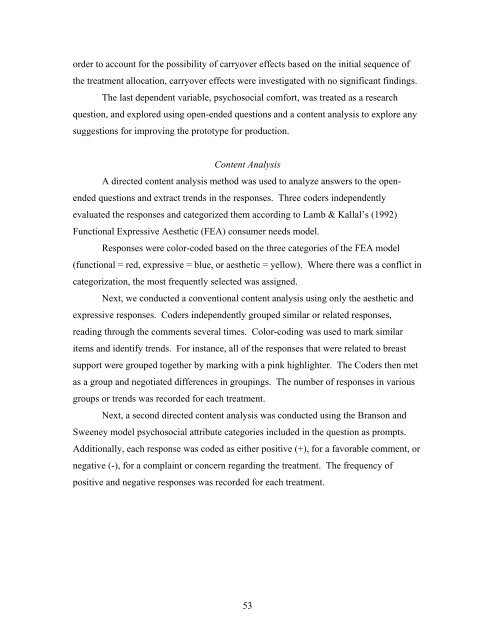Theory & Literature Review - Florida State University
Theory & Literature Review - Florida State University
Theory & Literature Review - Florida State University
You also want an ePaper? Increase the reach of your titles
YUMPU automatically turns print PDFs into web optimized ePapers that Google loves.
order to account for the possibility of carryover effects based on the initial sequence of<br />
the treatment allocation, carryover effects were investigated with no significant findings.<br />
The last dependent variable, psychosocial comfort, was treated as a research<br />
question, and explored using open-ended questions and a content analysis to explore any<br />
suggestions for improving the prototype for production.<br />
Content Analysis<br />
A directed content analysis method was used to analyze answers to the openended<br />
questions and extract trends in the responses. Three coders independently<br />
evaluated the responses and categorized them according to Lamb & Kallal’s (1992)<br />
Functional Expressive Aesthetic (FEA) consumer needs model.<br />
Responses were color-coded based on the three categories of the FEA model<br />
(functional = red, expressive = blue, or aesthetic = yellow). Where there was a conflict in<br />
categorization, the most frequently selected was assigned.<br />
Next, we conducted a conventional content analysis using only the aesthetic and<br />
expressive responses. Coders independently grouped similar or related responses,<br />
reading through the comments several times. Color-coding was used to mark similar<br />
items and identify trends. For instance, all of the responses that were related to breast<br />
support were grouped together by marking with a pink highlighter. The Coders then met<br />
as a group and negotiated differences in groupings. The number of responses in various<br />
groups or trends was recorded for each treatment.<br />
Next, a second directed content analysis was conducted using the Branson and<br />
Sweeney model psychosocial attribute categories included in the question as prompts.<br />
Additionally, each response was coded as either positive (+), for a favorable comment, or<br />
negative (-), for a complaint or concern regarding the treatment. The frequency of<br />
positive and negative responses was recorded for each treatment.<br />
53
















